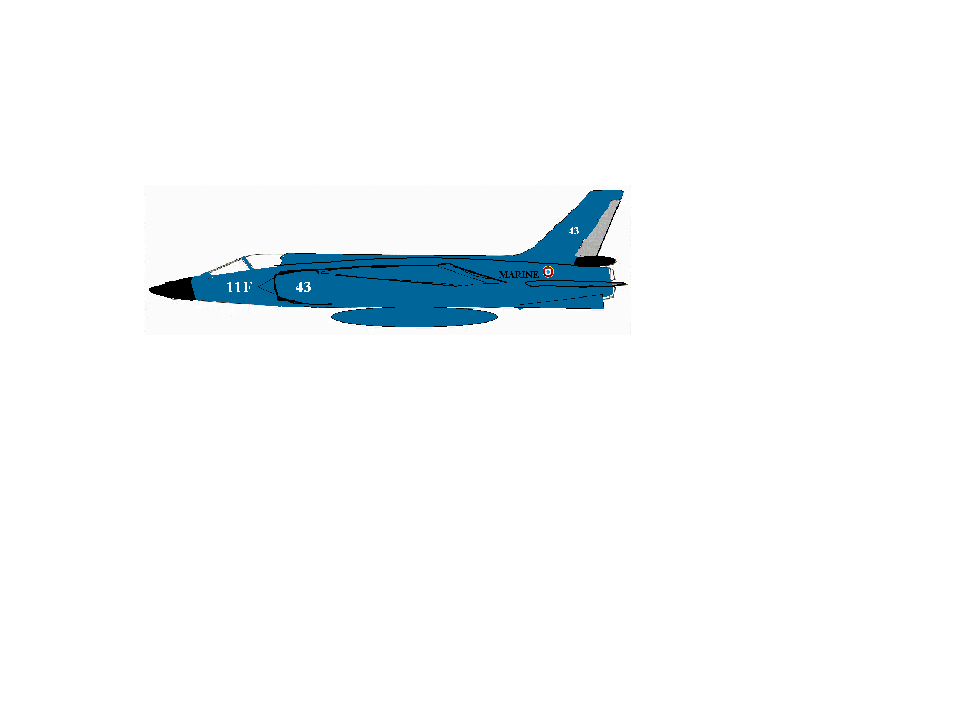Foch et Clémenceau
The Breguet 1120 Sirocco : a world beater.
In 1958, the French Navy need a mach2 interceptor for its future Foch and Clemenceau aircraft carriers. So, the Aeronavale asks Breguet to develop the 1120 Sirocco, a TAON derivative. At the same time, the Sea Vixen enter service in Great Britain, but this a subsonic fighter, who need to be replaced by a new mach2 fighter. The Saro SR177 had been kill by the defence white paper, there's no replacement available.
France order is in trouble, too : only 50 Sirocco would be built; this number is too short to order this brand new fighter.
We are in may 1959, air defence of the carriers is assured by Etendard IV and Sea Vixen. In June 1959, at Le Bourget Airshow, members of Breguet firm decide to contact the Royal Navy to propose a collaboration on the Sirocco. It's the only mean to save his aircraft, and to stay on the combat aircraft market.
The first contacts are good. An accord is rapidly settled between Breguet and the brand new BAC to produce a naval interceptor able to operate from both aircrafts carriers. The design is based on the Breguet 112, with British equipments. The French and Breguet rapidly admit that British engines and radar are superior to SNECMA or Thompson CSF products. That's why the Breguet 121 Cyclone will have the radar and engine of the BAC Lightning (AI-23 and RR Avon with 7400kgp). As with the Jaguar Tornado (German, Italian, English) or Concord(e) the name of the bird is the same in French and English…
The Mirage IIIO is used as testbed for the air intakes of the Cyclone; this particular Mirage III prototype, powered by a RR Avon, for Australia was rejected in favour of conventional Atar Mirage III. A BAC T4 lightning is also use. After some delays, because the French want a version with the Mirage III radar, the first flight of the Cyclone occur on 20th July 1961.
The plane is beautiful, very gracious. His performances are brilliant : His maximum speed is mach 2.32, the bomb load is interesting. Range is good, nearly 1000km in ordinary missions. The second prototype fly in February1962 and makes the first landing on an aircraft carrier on the Clemenceau on 21st February 1962. Breguet is clearly the chief of the project, but large parts of the aircraft are produced in Great Britain, including the engines. French aircrafts have the Cyrano II radar, and able to fire R-530 BVR missiles. British aircrafts have the superior AI-23 radar, and can fire Red Top missiles.
A comparison is made between the Cyclone , the Lightning and the Mirage III; concerning range, the Cyclone is much superior; in dogfight, the Cyclone is much agile than the Mirage III, but less powerful than the lightning; is climb rate is superior to the Mirage, but nothing can equal the Lightning climb rate.
Production starts in may 1963 and 200 aircrafts are produce, 80 for the French Navy and 120 for the Royal Navy. F11F and 800th squadron are the first transformed to the new aircraft, in January 1965. Sea Vixen are scrapped, whereas Etendard IV switch off to ground attack role.
What happen after was not predictable at the beginning of the program, but changed everything.
On those times, many navies in the world (including France, GB or even the USN) were still equipped with old aircrafts carriers, build during WWII. These carriers had a life duration of 50 years, and were not due to scrap until the 90's.
The trouble were the airplanes : these carriers were very small. The Americans have the Essex Class from this era. As they couldn't permit to scrap 27 aircrafts carriers in good shape, they have found an excellent solution : the air group were made only of Skyhawk and Crusaders. The Skyhawk was a fantastic plane, and his constructor MDD was cleaver enough to maintain open his production line for export until 1979. As a result, there was no shortage of good attack planes onboard small aircrafts carriers (from WWII era) in service all around the world.
The real trouble were the interceptors : harriers, Etendard, Skyhawk Corsair II were all subsonic, attack planes. The Crusader was ageing, and no other naval interceptor was on the production line… except the Cyclone. That's why, right from the start , many countries with small aircraft-carriers were interested by the airplane. The first to buy was Australia, which desperately seek an interceptor for his HMS Melbourne. 25 were bought, along with Mirage IIIO and TSR2, in a huge deal of armament.
Then, Netherlands and India. These two countries used the same "interceptor" , the antiquated, subsonic, straight wings Hawker P1040 Seahawk!!! 50 Cyclone were sold. Then, Argentina, for the "Veinticinco de Mayo" (they replaced, along Skyhawk the old Grumman Cougars of the Armada.).
At the beginnings of the 70's, the market was flourishing : the Americans mothballed their Essex carriers, and then started to sold them to others countries. These countries needed Skyhawk, but also a good mach2 interceptor… Cyclone sales were booming!!
France started to replace its good old Cyclone by Mirage F1EM in 1978
